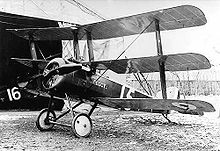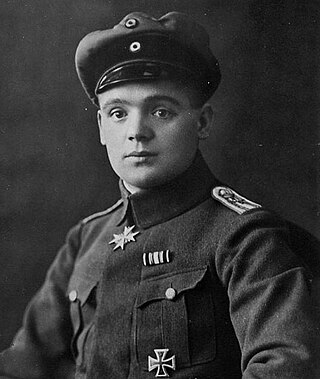
Julius Buckler was a German First World War fighter ace credited with 36 victories during the war. He shot down 29 enemy airplanes and seven observation balloons; two other victories went unconfirmed. He was one of only four German fighter aces to win Germany's highest decorations for valor for both enlisted man and officer.

Walter Kuno Reinhold Gustav von Bülow-Bothkamp, Pour le Merite, Military Order of Saint Henry, Iron Cross was a German fighter ace from an aristocratic family who was credited with 28 victories. After entering World War I as a hussar, he transferred to the Imperial German Air Service. Although flying a reconnaissance airplane, he managed to down two enemy planes in France in October 1915. He was then transferred to Palestine for 1916; he scored two more victories there. He returned to the Western Front to join Jagdstaffel 18, a fighter squadron. After shooting down nine more enemy planes, he was transferred to command Jagdstaffel 36. He would run his score to 25 enemy airplanes shot down and three observation balloons destroyed by 2 December 1917. He received Germany's highest award for valor, the Pour le Merite, on 8 October 1917. He was also transferred to a more prestigious command, Jagdstaffel 2, on 13 December 1917. On 6 January 1918, he was killed in action.

LeutnantFritz PütterPour le Mérite, Iron Cross, was a German World War I ace fighter pilot credited with victories over eight enemy observation balloons and 17 airplanes.
Leutnant Georg Meyer was a German World War I fighter ace credited with confirmed victories over six enemy observation balloons and 18 enemy aircraft.
LeutnantHans Martin Pippart Iron Cross was a pioneer aircraft manufacturer and early pilot. As a World War I German fighter ace he was credited with 22 victories.
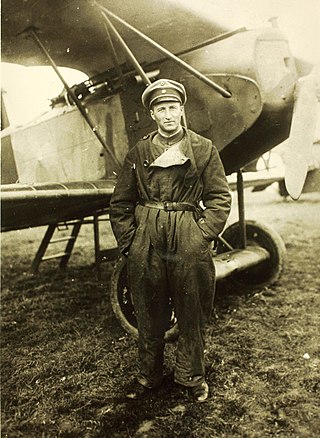
Doctor OberleutnantOtto Schmidt HOH, IC was a German World War I fighter ace credited with 20 aerial victories, including eight against enemy observation balloons. He commanded three different jagdstaffeln (squadrons) as well as a jagdgruppe.
Hauptmann (Captain) Friedrich-Karl Burckhardt was a World War I flying ace credited with five aerial victories. He was a professional soldier who already held a pilot's license when World War I began. He served on the Eastern Front until 28 November 1916, when he was promoted to command Jagdstaffel 25 in Macedonia. On 25 February 1918, he was withdrawn back to Germany, where he eventually commanded a home defense squadron until war's end. He scored victories over British, Italian, and French pilots, and was one of the few German aces to serve in aviation for the entirety of World War I.
OberleutnantErich Hahn was a World War I flying ace credited with six aerial victories.
OffizierstellvertreterWilhelm Kühne was a World War I flying ace credited with seven confirmed aerial victories and five unconfirmed ones.
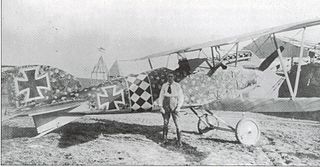
VizefeldwebelFritz John Jacobsen was a German World War I flying ace credited with eight confirmed and two unconfirmed aerial victories.
LeutnantWalter Böning was a German World War I flying ace from the Grand Duchy of Oldenburg credited with 17 aerial victories. He began his World War I military service as an infantryman. He distinguished himself by winning both the Gold Medal for Bravery and the Second Class Iron Cross. He then transferred to aviation duty, training originally as a reconnaissance pilot before advancing to become a fighter pilot. Between 6 April 1917 and 30 May 1918, he was credited with 17 aerial victories. On 31 May 1918, he survived a midair collision while being attacked by British fighters. Although he coaxed his damaged machine home, the serious leg wound he had suffered sidelined him through war's end.
Hans Joachim Rolfes was a German World War I flying ace credited with 17 confirmed and two unconfirmed aerial victories. He scored his first confirmed victory while with Royal Bavarian Jagdstaffel 32, on 6 July 1917. His second and subsequent victories were while leading Royal Prussian Jagdstaffel 45 during the first nine months of 1918. On 29 September 1918, he was additionally given command of a four squadron wing. Rolfes died in an aviation accident on 12 August 1935.
Leutnant Johannes Klein was a German World War I flying ace credited with 16 confirmed and two unconfirmed aerial victories. He should not be confused with another Johannes Klein, who was actually the driver for and present during the assassination of Reinhard Heydrich.
Leutnant Julius Schmidt was a World War I flying ace credited with 15 confirmed and three unconfirmed aerial victories.
Leutnant Heinrich Arntzen was a German World War I flying ace credited with eleven aerial victories.
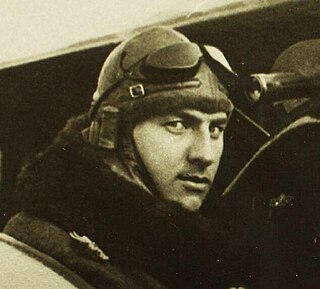
Franz Xaver Danhuber was a German World War I flying ace credited with eleven aerial victories.

Oskar Hennrich was a German World War I flying ace credited with 20 aerial victories. He was a notable balloon buster, since thirteen of his wins were destructions of the observation balloons. He was the leading ace of his squadron, and ended his service with the rank of Vizefeldwebel.

Leutnant Richard Wenzl was a German World War I flying ace credited with twelve aerial victories.
Leutnant Franz Brandt was a German World War I flying ace credited with ten confirmed aerial victories, as well as three unconfirmed claims.
Royal Prussian Jagdstaffel 25, commonly abbreviated as Jasta 25, was a "hunting group" of the Luftstreitkräfte, the air arm of the Imperial German Army during World War I. The squadron would score 54 aerial victories during the War – 46 enemy aircraft and eight opposing observation balloons. It would suffer two pilots killed in action, one pilot killed in a flying accident, and two others injured in mishaps.

